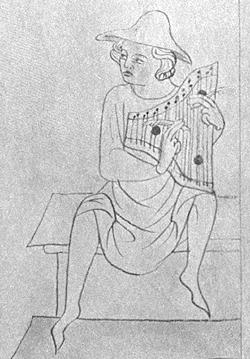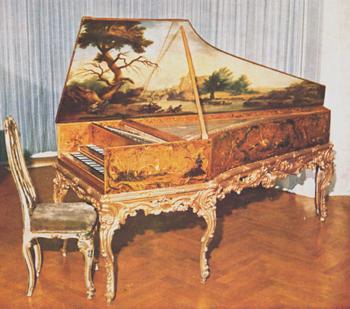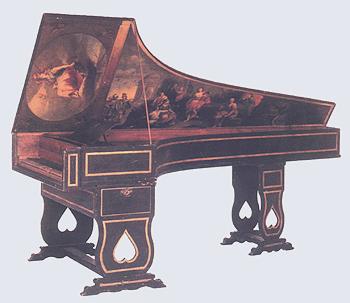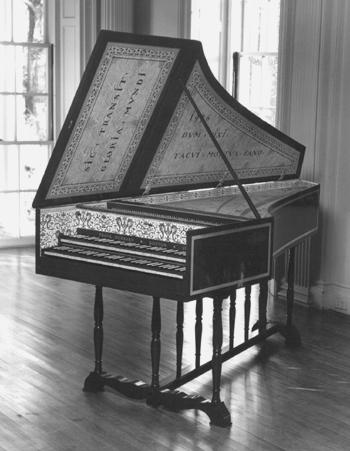A Brief History of the Harpsichord
The harpsichord is a musical instrument whose strings are plucked from a keyboard and which
sits on a table or stand while being played. They have been made in varying shapes, sizes
and sounds over the years. They were called virginals in Elizabethan England, a term today
reserved in English for harpsichords whose strings are parallel to the keyboard.
1300
The ancestor of the harpsichord was the psaltery. When played with a plectrum held in one hand,
and the strings damped by the other hand, it could handle rapid organal parts. In this example,
a drawing in the Velislav Bible of 1340, it is being plucked with both hands, playing with a
harp and bells. From the attention the player is paying to the harpist, she is obviously
playing a subordinate part.
The psaltery is occasionally shown being played flat on a lap, but it is then easily confused
with the dulcimer, which was struck with hammers like a xylophone.
| |

|
|
By the late 1300s, a keyboard was being added to the psaltery, at right angles to the soundboard
in a manner similar to portative organs of the time. It remained a small hand-held instrument
and had the Latin name clavicytherium. This is probably the instrument referred to as an exaquir
in 1387,
"an instrument like an organ which sounds by means of strings".
This wood carving is in Kefermarkt, Austria.
| |

|
1400
What we know today as a harpsichord seems to have evolved in the early 1400s in Flanders.
The earliest ones had the thick cases typical of later Flemish instruments, but were small
by later standards and had no jack rail. Their complex plucking mechanisms survive in a
set of drawings c1440 by Henri Arnaut in Burgundy. Some of these plucked the strings with
a quill like the psaltery, some with metal plectra, and at least one struck the strings with a metal
staple in the manner of the dulcimer. The earliest surviving representation
is an altar carving from Germany ca.1425. The second is from England: a beautiful stained
glass window attributed to John Prudd c1440 in the Beauchamp chapel of St.Mary's Church,
Warwick England that clearly shows its Flemish influence in the case decoration.
(I thank Charlie Callery for a colour photo of this window.)
| |

|
1500
 By 1500, however, Italian makers have taken over. All harpsichords appear to be plucked by
simple
jacks sliding in a guide between a keyboard and a jack rail. The Italian case is light and the
stress of the strings supported by internal knees. The keyboard range has doubled from the
earlier northern instruments. And, the harpsichord has taken the musical world by storm.
By 1500, however, Italian makers have taken over. All harpsichords appear to be plucked by
simple
jacks sliding in a guide between a keyboard and a jack rail. The Italian case is light and the
stress of the strings supported by internal knees. The keyboard range has doubled from the
earlier northern instruments. And, the harpsichord has taken the musical world by storm.
Some 40 instruments survive essentially intact from the 1500's. Almost all are Italian.
This may be because in later centuries, northern instrument makers moved
towards heavier, longer strings that would have pulled their early instruments apart. Italian
instruments kept light short strings throughout the harpsichord era, and could continue to
adapt their old instruments to later tastes. But, the earliest references to harpsichords
are all from north of the Alps.
Most early Italian harpsichords were single strung, some had an octave string set; only a few had
doubled
fundamental strings. Some, such as this one, the earliest surviving unmodified harpsichord, by
Domenicus Pisaurensis (Domenic of Pesaro) of 1533, have both nut and bridge on a soundboard.
This is the instrument of the 'father of music', Wm. Byrd, and the other English virginalists.
Harpsichords were very variable in pitch at this time. There seems, however, to have been a
tendency to cluster
around two scales. These probably sounded about a fourth apart, with the lower one matching the
pitch of the lute.
|
Early in the 1500s, a small form of the harpsichord appears in Italy, the spinetta, with single
strings parallel
to the keyboard. It has a pentagonal outline, and both ends of the strings rest on a soundboard.
(The
instrument attributed to Queen Elizabeth I is an Italian pentagonal spinetta.) They were
made in Flanders as well, as shown in a delicate painting by Caterina de Hemessen in 1548.
| |

|
|
About 1560, the Flemish began making the spinetta bigger, with a rectangular outline.
The most popular instrument of this type was called a muselaar, and sounded like a
lute. Others sounded like the Italian instruments, but had a wider range.
This painting of student and teacher is by Jan VerMeer, c1660.
Also at this time, the Flemish made the first known efforts to vary the sound of the basic
harpsichord. The muselaars had a set of metal pins which could be slid up to the strings near
one end. Two-manual harpsichords appear by 1580, with the spinetten sound on the upper
manual
and a lute sound on the lower (but not as much so as the muselaar). The Flemish also made
elaborate virginal pairs an octave apart - these could be played as two entirely separate
instruments, as a two manual instrument, or be coupled together to sound as one.
| |

|
1600
 By 1640, two fundamental strings played together predominated in Italian practise and most of
the old ones were converted to this style. (The oldest surviving harpsichord, by Hieronymus
Bononiensis in 1521, was originally single strung.) Italian practise then remained largely
unchanged as long as the harpsichord was used. Further development of harpsichords was
based on the Flemish models of the late 1500s.
By 1640, two fundamental strings played together predominated in Italian practise and most of
the old ones were converted to this style. (The oldest surviving harpsichord, by Hieronymus
Bononiensis in 1521, was originally single strung.) Italian practise then remained largely
unchanged as long as the harpsichord was used. Further development of harpsichords was
based on the Flemish models of the late 1500s.
During this century, the harpsichord range was increased. Most early instruments cover less
than 4 octaves, this was gradually expanded to 5 octaves. Often this was done by retuning
the bass octave to omit
sharp notes, thus reaching deeper notes with no change to the instrument. In this 1677
instrument by Fabry of Bologna, the range has been extended by splitting the lowest two
sharp keys and squeezing two new sets of strings into an existing design.
|
A compact form of single-strung harpsichord, the wing-shaped spinet began to replace the
Flemish virginals as the preferred domestic instrument late in the 1600s. This one, by
Thomas Hitchcock, is similar to the one at Fenton House that told me that the harpsichord
was my instrument.
| |

|
1700
The number of strings increased, large instruments often having three choirs per note.
And, the choirs were now designed to be easily selected by the player in various
combinations for different sound effects.
Two manual instruments became more common (but were always in the small minority).
Usually the choirs used by an upper manual were voiced more quietly than those used by
the lower, allowing choice of a forte-piano contrast as well as a tonal contrast.
Despite these changes, however, the essential mechanical layout and sound of the Flemish
instruments of the mid-1500s were retained in northern instruments during the 1700s.
This was the instrument for which the
Couperins, J.S.Bach, Handel, Haydn, and the other great northern composers wrote.
This example is an 18th century French rebuild of a 1623 Ruckers.
(Photo courtesy Michael Meacock)
| |

|
|
Only in Spain and Portugal was there any significant development of the Italian harpsichord,
the range was increased to the 5 octaves used by Domenico Scarlatti. This 1785 example
is by Joachim José Antunés.
| |

|
1800
Essentially, use of the harpsichord ceased by 1800. The precision and clarity of the baroque
had been replaced by mush and bombast.
|
1900
Several German firms experimented with plucked pianos late in the 1800's. By 1900, a young
Polish pianist, Wanda Landowska, had figured out how to make good music with them and, in
1912, the French firm of Pleyel brought out a model designed for her, shown
at right. Ralph Kirkpatrick and others
used similar instruments to join her in developing a wholly new sound that blended piano and
organ techniques of the time. A French violinist,
Arnold Dolmetsch, made a number of instruments at several workshops based on English
harpsichords of the late 1700s, but without their sonority - they attracted few admirers.
Some of the surviving large harpsichords were modified by replacing a set of strings by strings
an octave below normal pitch - at least one such modified instrument was attributed to J.S.Bach.
| |

|
|
The revival of the instruments with the sound that ravished three centuries of the world's
most discerning musicians began with Frank Hubbard's studies with Hugh Gough in 1948,
his research that culminated in his "Three Centuries of Harpsichord Making" of 1965,
and all the apprentices he trained. (My instrument was made by Wm.Ross, an early Hubbard
apprentice.) By the late 1900s, many craftsmen made instruments as musical
as the old, such as this 1976 Ruckers/Taskin harpsichord by Hubbard. And,
many performers played them as well as the old.
| |

|
2000
If you want to buy a harpsichord,
Hubbard Harpsichords
makes as fine instruments as have ever been made. The
Harpsichord Clearing House
is the best source of used instruments I know of. If you want to learn about old instruments, read
the Galpin Society Journal and the
Quarterly
of the Fellowship of Makers and Researchers of Historical Instruments.
John Sankey 2001
other notes on harpsichord playing



 By 1500, however, Italian makers have taken over. All harpsichords appear to be plucked by
simple
jacks sliding in a guide between a keyboard and a jack rail. The Italian case is light and the
stress of the strings supported by internal knees. The keyboard range has doubled from the
earlier northern instruments. And, the harpsichord has taken the musical world by storm.
By 1500, however, Italian makers have taken over. All harpsichords appear to be plucked by
simple
jacks sliding in a guide between a keyboard and a jack rail. The Italian case is light and the
stress of the strings supported by internal knees. The keyboard range has doubled from the
earlier northern instruments. And, the harpsichord has taken the musical world by storm.


 By 1640, two fundamental strings played together predominated in Italian practise and most of
the old ones were converted to this style. (The oldest surviving harpsichord, by Hieronymus
Bononiensis in 1521, was originally single strung.) Italian practise then remained largely
unchanged as long as the harpsichord was used. Further development of harpsichords was
based on the Flemish models of the late 1500s.
By 1640, two fundamental strings played together predominated in Italian practise and most of
the old ones were converted to this style. (The oldest surviving harpsichord, by Hieronymus
Bononiensis in 1521, was originally single strung.) Italian practise then remained largely
unchanged as long as the harpsichord was used. Further development of harpsichords was
based on the Flemish models of the late 1500s.




